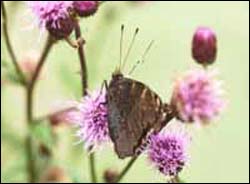Radar tracking reveals that butterflies follow decisive flight paths

Butterfly with antenna attached. BBSRC and Rothamsted Research
The charming meanderings of butterflies are not as random as they appear, according to new research1. Scientists at Rothamsted Research,2 a research institute sponsored by the Biotechnology and Biological Sciences Research Council (BBSRC) in Hertfordshire, have found that their seemingly irresolute flutterings are in fact decisive flight paths. The harmonic radar has been used before to track the flights of bumblebees and honeybees. Now it has been shown to work for butterflies too, opening a new window on the flight behaviour of these important pollinating species.
BBSRC-funded researcher Lizzie Cant has attached tiny radar transponders, weighing only about 12mg (4-8% of body weight), to peacock or small tortoiseshell butterflies. This allows her to use harmonic radar to track the butterfly’s position accurately up to 1km away. Previous studies had to use visual observation (difficult over 50m) or indirect mark-recapture techniques.
Butterflies were tracked undertaking fast, directed flights to potential feeding sites or interspersing periods of foraging with looping “orientation” flights. Knowing how butterflies navigate can help us understand how capable they are of maintaining sustainable populations in our increasingly fragmented countryside.
Lizzie Cant said, “Butterflies are important pollinators, providing a crucial service to plants in many ecosystems. This research will help us to understand a little more about how they survive in a countryside that is becoming more and more fragmented.”
Media Contact
More Information:
http://www.bbsrc.ac.ukAll latest news from the category: Life Sciences and Chemistry
Articles and reports from the Life Sciences and chemistry area deal with applied and basic research into modern biology, chemistry and human medicine.
Valuable information can be found on a range of life sciences fields including bacteriology, biochemistry, bionics, bioinformatics, biophysics, biotechnology, genetics, geobotany, human biology, marine biology, microbiology, molecular biology, cellular biology, zoology, bioinorganic chemistry, microchemistry and environmental chemistry.
Newest articles

High-energy-density aqueous battery based on halogen multi-electron transfer
Traditional non-aqueous lithium-ion batteries have a high energy density, but their safety is compromised due to the flammable organic electrolytes they utilize. Aqueous batteries use water as the solvent for…

First-ever combined heart pump and pig kidney transplant
…gives new hope to patient with terminal illness. Surgeons at NYU Langone Health performed the first-ever combined mechanical heart pump and gene-edited pig kidney transplant surgery in a 54-year-old woman…

Biophysics: Testing how well biomarkers work
LMU researchers have developed a method to determine how reliably target proteins can be labeled using super-resolution fluorescence microscopy. Modern microscopy techniques make it possible to examine the inner workings…





















